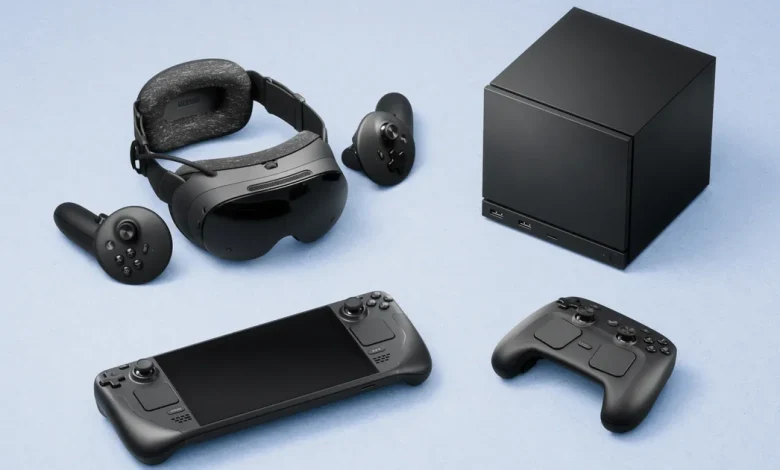Valve to take on PlayStation and Xbox with new Steam Machine console and controller – plus a new standalone Steam Frame VR headset

It’s Valve time. The Bellevue-based firm is making three hardware announcements today, including a new Steam Machine mini PC that it claims is more than six times as powerful as the Steam Deck, a revised Steam Controller with more mainstream appeal, and the Steam Frame, a new standalone VR headset that marks the debut of SteamOS on ARM mobile chips. All three are due to arrive in early 2026.
We’ve been briefed on each announcement and had a chance to speak with Valve’s designers, and based on those discussions it’s clear that while these are in some ways logical extensions of prior products, each is also set to break ground in some interesting and unexpected ways.
Together, the three also form an arsenal that positions Valve as an increasingly important player alongside the likes of Sony, Microsoft and Nintendo, both as a maker of gaming hardware and as the architects of the most credible challenger to the Windows operating system for gaming.
We’ll summarise each announcement below, but we also have full tech previews for each product that go more in depth via the links below:
Steam Machine: a powerful, customisable mini PC for couch gaming
The Steam Machine is essentially only a little larger than a 140mm PC case fan, or around the same size as a GameCube.
What happens if you take the Steam Deck, Valve’s popular PC gaming handheld, leave out the screen and the battery, and pump up the power? The Steam Machine is just such a device, a six-inch cube of a PC that happily sits under a TV to bring your library of Steam games to the living room. Like a PlayStation 5 or Switch 2, it’s powerful enough to produce convincing levels of detail for a 4K TV, and Valve says that it should be able to run most of the Steam Library at a smooth 60fps too – even including some more visually demanding games with ray tracing features, like Cyberpunk 2077.
That level of performance relies on three things: capable discrete graphics hardware (AMD RDNA 3), significantly more power on tap (~200W), and continuing improvements to Proton, the compatibility layer that lets Windows games run on the Linux-based SteamOS (and sometimes runs them faster than on Windows). All told, Valve says that the Steam Machine is six times more powerful than the Steam Deck.
The Steam Machine also has some unique features that make it more suited to the living room, including a light bar across the front that shows download progress and other information, the ability to control a TV’s power and input using HDMI-CEC, and an integrated power supply that minimises clutter. There are even swappable face plates, from the standard black plastic included with the unit to fancier wooden facades. Airflow is always a concern, as TV stands can often collect heat, so the Machine dedicates much of its internal area to cooling – and is essentially built around a large 140mm fan.
Here’s the port report: one MicroSD and two USB 2 ports up front, plus two USB 3, one USB-C, gigabit ethernet, HDMI 2.0 and DisplayPort 1.4 ports on the back. | Image credit: Valve/Eurogamer
In comparison to the single USB-C port of the Steam Deck, the Steam Machine is absolutely festooned with ports, allowing you to connect two displays, five USB peripherals and wired internet. There’s also a focus on wireless connectivity, with a dedicated 2.4GHz radio for the Steam Controller (which we’ll cover in the next section), a dedicated Bluetooth antenna and fast Wi-Fi 6E. The idea is that, with so many dedicated radios, wireless peripherals should work more consistently across the slightly larger distances common in living rooms.
You’ll be able to choose models with 512GB or 2TB of internal storage, which can be upgraded by adding MicroSD cards or changing the included SSD, which is easy to access by unscrewing the bottom of the machine. You can also move games directly from a Steam Deck or Steam Frame if they’re installed on a MicroSD card. Valve is planning to sell the Machine standalone or bundled with the Steam Controller.
Prices haven’t been announced ahead of the early 2026 launch, but Valve told me that pricing should be in the same ballpark as consoles – though whether that is closer to the £400 Switch 2 or £700 PlayStation 5 Pro remains to be seen. Given how streamlined and easy to use SteamOS is compared to even the handheld-optimised versions of Windows these days, I can see the Steam Machine being an intriguing option for veteran and new PC gamers alike.
Steam Controller: a more mainstream gamepad for playing PC games on your TV
Image credit: Valve
The Steam Controller is far more than than the gamepad that comes with the Steam Machine – it’s the return of a cult favourite controller 10 years later. The 2015 original looked a bit weird, with two big concave touchpads instead of the traditional controls you’d expect, but these additions allowed you to play PC games designed for a keyboard and mouse on a gamepad.
The new 2025 model is a refined version of the same concept, with traditional controls up top and squarer touchpads below, looking more similar to those on the Steam Deck. However, they’ve been tilted inwards slightly to suit this form factor, and you’ll find other ergonomic tweaks compared to both the original Steam Controller and the Steam Deck.
The Steam Controller is also arguably the first “first-party” console gamepad to ship with TMR thumbsticks, named after a new kind of magnetic sensor that is more precise and is more resistant to durability issues like stick drift. Hall Effect triggers aren’t included, as these are a more traditional design, but you do get four extra rear buttons, a feature we see in many of the best PC gamepads.
Here’s what those additional rear buttons look like – and you can also see the magnetic pins where the charger attaches. | Image credit: Valve/Eurogamer
The controller also comes with gyro-based motion controls, which can be toggled on and off based on how you’re holding the controller – so it’s only active when you actually want it to be. The haptics have also been souped up, with a high fidelity motor in each grip and under each touchpad, for four in total.
The Steam Controller’s default connection method is proprietary 2.4GHz wireless, which offers competitive end-to-end input latency of 8ms. You can also plug the controller in for a wired connection or use Bluetooth. The Steam Machine has the necessary 2.4GHz radio built in, but for other devices you’ll want to use the included dongle. As well as connecting up to four Steam Controllers, this dongle also magnetically attaches to the back of the gamepad to charge it.
It’ll be fascinating to see if the Steam Controller finds a more mainstream audience than its predecessor, but there’s plenty here to suggest that Valve is on the right track – especially in terms of customisability and adaptability, which seems better than ever.
Steam Frame: standalone VR and the debut of SteamOS on ARM
As a package, the Steam Frame shows clear learnings from the excellent, if slightly complex, Valve Index from 2019.
The Steam Frame is Valve’s take on the Meta Quest, a standalone VR headset with motion controllers that can play games or stream them from a nearby PC with some unique tech that could give it a quality advantage.
Like the Quest, the Core of the Steam Frame is built around a Snapdragon 8 Gen 3 chipset, with 16GB of memory and 256GB or 1TB of storage depending on the model you choose. The headset weighs a relatively light 435 grams in total, with the weight of the computer, pancake lenses and 2160×2160 72-144Hz displays being balanced out with speakers on the sides and a 21.6Wh battery on the back. The maximum field of view is 110 degrees, both vertically and horizontally.
The Steam Frame uses inside-out tracking, relying on four monochrome cameras on the outside to see where the headset and the controllers are moving. Unusually for VR controllers, you get a full set of console-style inputs here, so any game that has controller support on Steam ought to run here. The Frame Controllers also get the TMR thumbsticks found on the Steam Controller, capacitive finger sensing, haptic feedback and 40 hours of battery life from a single AA battery. You also have the option of using the Steam Controller or indeed other gamepads.
Here’s a closer look at the controllers and VR headset itself. Note the cable running from the battery pack to the rest of the headset, allowing the straps on each side to be slimmer. | Image credit: Valve
As well as the external cameras, there are two internal cameras used for eye tracking. This ties into the Frame’s secret weapon for streaming games in higher quality, which is called Foveated Streaming. This means that the video stream concentrates the majority of its bandwidth exactly where you’re looking, with the remainder left to fill in the gaps. That boosts the perceived clarity of the headset significantly, and the fact that Valve is able to do this fast enough on streamed video is impressive. You even get a Wi-Fi 6E dongle in the box to ensure that your wireless connection is up to snuff, while the headset includes separate 5GHz and 6GHz radios to ensure that there’s no contention between accessing the internet and receiving the streamed data.
As well as playing VR games like Half-Life Alyx, you can also play “flat” non-VR titles in a virtual space. For example, Valve mentioned playing Hades 2 at 1440p 90fps in our briefing. That level of performance is impressive for a recent PC release, especially as games need to run via a translation layer called Fex that adapts traditional x86 and x64 PC instructions into something the ARM-based processor in the Frame can understand. Games that are able to run well on the Frame will get a “Frame Verified” rating visible in the Steam library and store, similar to the “Deck Verified” programme used for vetting games on the Steam Deck.
It will be interesting to see how well SteamOS and Steam games run directly on the Frame, and whether Valve’s Foveated Streaming tech is able to outperform rivals like Quest 3 for game streaming. Pricing also remains unknown, though I’d expect a lower price than the premium Index with its many more components. Still, there’s plenty here to be excited about for VR fans, and it could be a great introduction to the space for people that have never strapped on a headset before too.
Wrapping up: what does this all mean?
As well as being interesting pieces of kit in their own right, it’s clear that Valve has ensured that the Deck, Frame, Machine and Controller all work nicely together too, with game swapping on MicroSD cards, more input options and streaming all in the mix. No matter what combination you get, the promise is that, come early 2026, you’ll have the flexibility to play a huge library of PC games in a variety of locales. That certainly benefits Valve, and it ought to be welcomed by the majority of PC gamers that rely on Steam over other stores too.
With this powerful new hardware, plus its existing status as the de facto choice for both PC game sales and handheld gaming hardware, Valve looks increasingly like a direct competitor to console makers Sony, Nintendo and Microsoft, not to mention the entire Windows OS and Meta’s VR ecosystem. If you can play the majority of your game library on a Steam Machine or a Steam Frame, and pick up games on sale cheaper than they are on consoles, why would you ever buy an Xbox?
I believe its designers when they say that they’re not really motivated by competing with console makers or anyone else, they’re just doing their own thing, but that doesn’t lessen the size of the potential impact. After all, Valve is famously ponderous and idiosyncratic when it comes to releasing new products – Valve Time is a meme for a reason – but like Apple, it tends to hit extremely hard when it enters a new category, and that looks set to happen again here.
As always, this is just a preview; we need to go hands-on with the final hardware and software to say for sure, but Valve has certainly made the next few months much more interesting.





